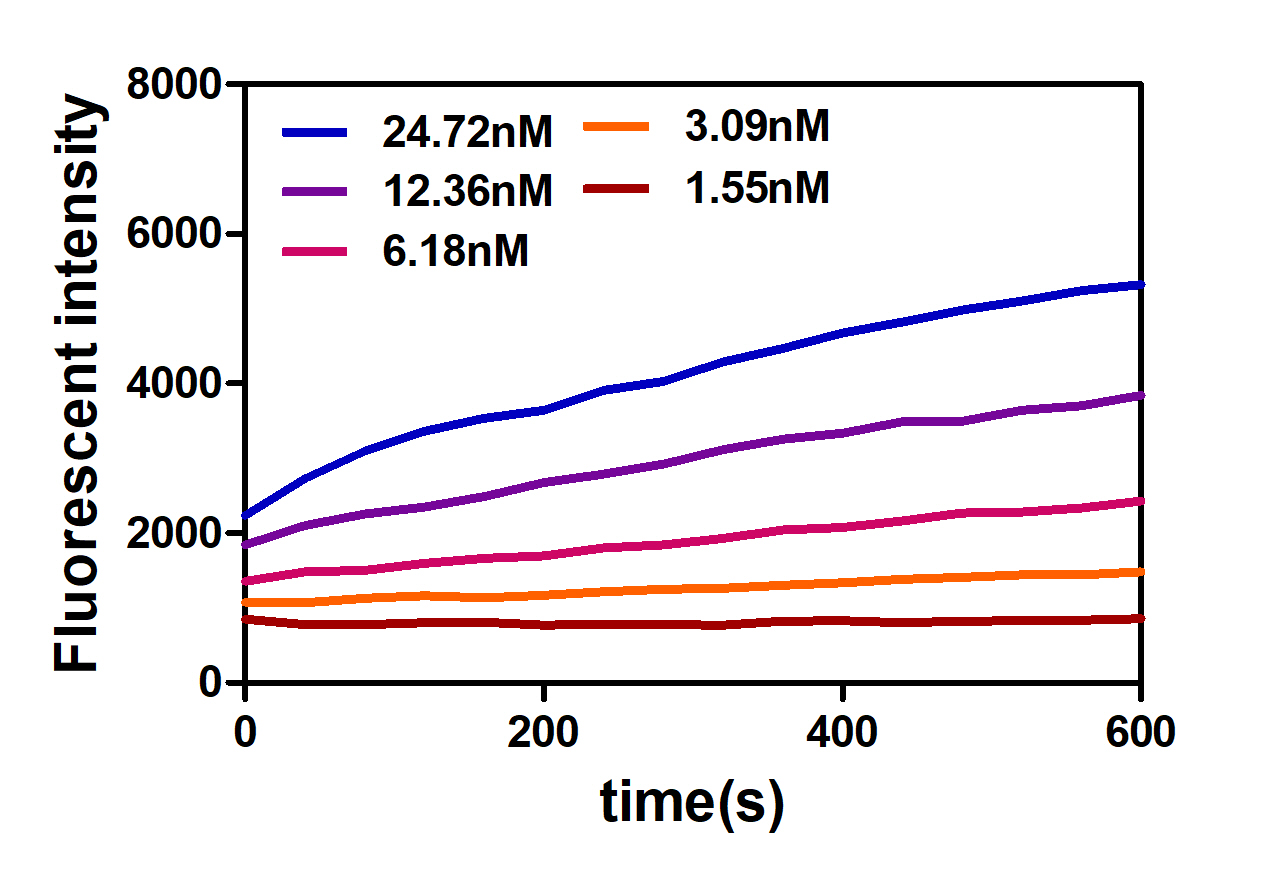Difference between revisions of "Part:BBa K2933002"
(→Expression and purification) |
(→Determination of enzyme concentration) |
||
| Line 64: | Line 64: | ||
====Determination of enzyme concentration==== | ====Determination of enzyme concentration==== | ||
<p style="text-align: center;"> | <p style="text-align: center;"> | ||
| − | [[File:T--TJUSLS China-- | + | [[File:--File-T--TJUSLS China--SPG enzyme 1--.jpeg]]<br> |
'''Figure 2.''' The concentration of CDC-1 was fixed at 10.5 μM and the enzyme concentration was changed within a certain range, and the fluorescence value was measured with a function of reaction time. (a) First, we selected three gradient concentrations (with large intervals) for pre-experiment, and determined the gradient range of the formal experiment through the experimental results. (b) The appropriate enzyme concentration was selected for determination of the gradient, and the reaction curve of gradual rise was obtained.<br> | '''Figure 2.''' The concentration of CDC-1 was fixed at 10.5 μM and the enzyme concentration was changed within a certain range, and the fluorescence value was measured with a function of reaction time. (a) First, we selected three gradient concentrations (with large intervals) for pre-experiment, and determined the gradient range of the formal experiment through the experimental results. (b) The appropriate enzyme concentration was selected for determination of the gradient, and the reaction curve of gradual rise was obtained.<br> | ||
</p> | </p> | ||
Revision as of 03:41, 6 September 2019
subclass B3 metallo-beta-lactamase SPG-1, codon optimized in E. coli
This part encodes a protein called SPG-1, which is a metallo-beta-lactamase of subclass B3.
Sequence and Features
- 10COMPATIBLE WITH RFC[10]
- 12COMPATIBLE WITH RFC[12]
- 21COMPATIBLE WITH RFC[21]
- 23COMPATIBLE WITH RFC[23]
- 25COMPATIBLE WITH RFC[25]
- 1000COMPATIBLE WITH RFC[1000]
Usage and Biology
References
Molecular cloning
Expression and purification
Pre-expression:
The bacteria were cultured in 5mL LB liquid medium with ampicillin(100 μg/mL final concentration) in 37℃ overnight.
Massive expressing:
After taking samples, we transfer them into 1L LB medium and add antibiotic to 100 μg/mL final concentration. Grow them up in 37°C shaking incubator. Grow until an OD 600 nm of 0.8 to 1.2 (roughly 3-4 hours). Induce the culture to express protein by adding 0.3 mM IPTG (isopropylthiogalactoside, MW 238 g/mol) or ~0.1 gram per 1.5 liter flask. Put the liter flasks in 16°C shaking incubator for 16h. Centrifuge your bacteria in 500 mL bottles in the 4°C rotor at 4,000 RPM for 20 mins. Do this in batches until all your culture is spun down saving the cell pastes each time.
Purification of GST fusion proteins:
Anion exchange column:
According to the predicted pI of the protein and the pH of the ion-exchange column buffer, firstly select the appropriate ion exchange column (anion exchange column or cation exchange column). The pH of buffer should deviate from the isoelectric point of the protein. Since the isoelectric point of our protein is around 5 in theory, we choose buffer pH of 7.4 and use anion exchange column for purification.
The protein is concentrated with a 10KD concentration tube, and then the exchange buffer is used to exchange the protein to the ion-exchange liquid A. Finally, it is concentrated to less than 5ml by centrifuging at 4℃ and 3400rpm for 10 minutes in a high-speed centrifuge to remove insoluble substances and bubbles.
Balance the selected column with liquid A. Through the AKTApure protein purification system, the samples are loaded to the column at a flow rate of 0.5ml/min, and continue washing for 5min. Gradually increase the content of liquid B in the column, change the salt concentration and then change the interaction between the sample and the column, and collect the corresponding eluent according to the position of the peak. Use SDS-PAGE to check the result.
Gel filtration chromatography:
The collected protein samples are concentrated in a 10 KD concentrating tube at a speed of 3400 rpm and concentrated for a certain time until the sample volume is 500 μl. At the same time, the superdex 200 column is equilibrated with a buffer to balance 1.2 column volumes. The sample is then loaded and 1.5 cylinders are eluted isocratically with buffer. Determine the state of protein aggregation based on the peak position and collect protein samples based on the results of running the gel.

Figure 1. (a) The result of gel filtration used the superdex75 column with the AKTA system, which shows that the target protein is monomeric. (b) The result of SDS-PAGE. And the target protein is about 28kD.
Enzyme activity determination
We used CDC-1, a probe with a similar structure from the beta lactam ring and a luminescent group for enzyme activity measurements. For more information on the substrate CDC-1, please see our project introduction.
Materials:
General 96-well plates (Black)
Infinite M1000 Pro Automatic Microplate Reader
Multi-channel adjustable pipette
Ultrasonic Cleaner
Buffer:
100% DMSO
Fluorescent Probe(CDC-1)
Target Enzyme(beta-lactamase)
Determination of enzyme concentration

Figure 2. The concentration of CDC-1 was fixed at 10.5 μM and the enzyme concentration was changed within a certain range, and the fluorescence value was measured with a function of reaction time. (a) First, we selected three gradient concentrations (with large intervals) for pre-experiment, and determined the gradient range of the formal experiment through the experimental results. (b) The appropriate enzyme concentration was selected for determination of the gradient, and the reaction curve of gradual rise was obtained.

Figure 3. We took the emission fluorescence at 3.02nm as the maximum emission fluorescence, and took the logarithm value of different NDM-23 enzyme concentrations to make the relationship curve between protein concentration and fluorescence emission rate. When the emittance of the system was 80%, the protein concentration was 1.51nM, that is, EC80 was 1.51nM.
